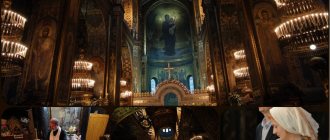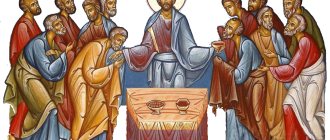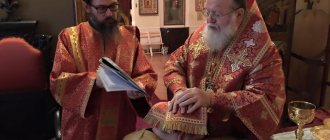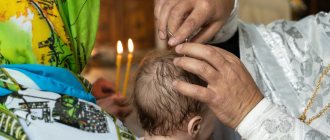The Sacrament of Confirmation is inextricably linked with the Sacrament of Baptism and is performed on a person only once in life: so, in order to preserve the spiritual purity received in baptism, to grow and strengthen in spiritual life, we need the special help of God, which is given in the Sacrament of Confirmation. Mentions of this sacrament are found already in the first centuries. After immersion in the font and the corresponding litany and secret prayer for the sending down of the Holy Spirit on the newly converted, the priest anoints the forehead, eyes, ears, nostrils, lips, chest and hands of the baptized person in a cross-shaped manner with holy oil with the words: “ The Seal of the Gift of the Holy Spirit .” For each anointing, after the words “seal of the gift of the Holy Spirit,” the priest recites special verses. Anointing the forehead (forehead) means sanctifying the mind or thoughts. Anointing the chest is the sanctification of the heart or desires. Anointing the eyes, ears and lips is the sanctification of the senses. Anointing hands and feet is the sanctification of the deeds and entire behavior of a Christian.
Holy Chrism (ancient Greek: μύρον “fragrant oil”) is a great shrine, which is usually kept on the throne. It is a special mixture of vegetable oils, fragrant herbs and fragrant resins (about 50 substances in total). The main substance for preparing the world is extra virgin olive oil. White grape wine is necessary when making myrrh to prevent the oil from flaming and burning. Among the fragrant substances, incense, rose petals, violet, spicy and galangal roots, nutmeg, rose, lemon and clove oils and others are usually used.
The Essence of the Sacrament
Modern church practice involves the combination of two Sacraments - Baptism and Confirmation. According to tradition, during Baptism, the baptized person dresses in new white clothes, as a symbol of purity and innocence before God. After this, a pectoral cross is put on him, which the believer must wear throughout his life.
The ritual of anointing in the Orthodox Church
And the next stage is the anointing of the newly made Christian with aromatic oil, which is cooked in a special way and consecrated personally by His Holiness the Patriarch.
Interesting! During the brewing of a new world, the remainder of the previous one is necessarily poured into it, and the succession of the holy liquid can be traced back to the apostles themselves.
The tradition of confirmation goes back to apostolic times. The Bible says that the grace of the Holy Spirit descended on newly baptized Christians after the laying on of the hands of the apostles on believers. Over time, when baptisms of people became widespread, the tradition arose of anointing various parts of the body with blessed oil instead of the laying on of hands. The apostles were physically unable to participate in the baptism of such a large number of people.
What exactly happens to a person during this Sacrament? This is described in the Gospel, when on the fiftieth day after the Resurrection God's grace descended on the apostles in the form of fiery tongues. After this, the apostles were filled with strength and ability to preach the faith of Christ throughout the world.
The same applies to ordinary Christians who decide to accept Baptism into the Orthodox faith. Only the descent of the Holy Spirit on ordinary people is not as obvious and visible as on the apostles. That is why Confirmation is considered a Sacrament - since it occurs invisibly, mysteriously.
Read about other Sacraments of the Church:
- Sacrament of Communion
- Sacrament of Confession
- Sacrament of Wedding
What happens during Confirmation can be compared to the sowing of grain. A small piece of holiness enters the soul and heart of a person. And it depends on the future life of the person himself whether this seed will bear fruit. If the person being baptized tries to live the fullness of Christianity, he will receive great spiritual gifts. And, on the contrary, the grace received can be easily lost if you lead a godless life and do not remember the Lord.
History of the establishment of the Sacrament of Confirmation
The establishment of the Sacrament of Confirmation dates back to apostolic times: already in the apostolic epistles themselves, the gift of the Holy Spirit that Christians possess is sometimes called “anointing” (1 John 2:20, 2 Cor. 1:21). Initially, the apostles laid hands on the newly baptized, but when this became practically impossible in remote places, they began to consecrate fragrant oil with a special rite and distribute it to the clergy to anoint the newly converted. After the death of the apostles, the chrism began to be consecrated only by a council of bishops (their immediate successors) headed by the primate of one or another Local Church. The Council of Laodicea (343) approved the following 48th rule:
It is fitting for those who are enlightened to be anointed with the Heavenly Anointing and to be partakers of the Kingdom of God.
By this, the Council consolidated the practice of performing confirmation immediately after baptism, which, probably, was not always done during the time of the Council of Laodicea. Confirmation was performed on a person for the second time in life, if the person was appointed through the church to the kingdom, the so-called “inaugural confirmation” (anointing for the kingdom, Greek τò χρίσμα τῆς βασιλείας) of monarchs. In this case, the anointing for the kingdom was the second, highest degree of the Sacrament of Confirmation.
In the Old Testament times, the Tabernacle, high priests, prophets and kings were anointed with myrrh. With the same peace they went to the tomb of Christ and the Myrrh-Bearing Woman. In addition to the Sacrament of Confirmation, myrrh is also used to consecrate new altars in churches. In Rus', holy myrrh began to be used with the adoption of Christianity. “We are all smeared with the same world” is a well-known Russian proverb, indicating the spiritual kinship that Christians gain through participation in common church sacraments. Until the middle of the 15th century, Rus' used the world brought from Constantinople, but after the approval of autocephaly, the Russian Orthodox Church began to prepare it itself.
History of the Sacrament and its differences
In ancient times, Confirmation was performed in a different way. The initial laying on of hands by the apostles on the newly baptized to convey Divine grace had to be replaced by some other action in order to include everyone who wanted to be baptized. Christianity spread very quickly, and sometimes people adopted the new faith in entire settlements.
Interesting! In order to perform the Sacrament over a large number of people, they began to consecrate a special aromatic oil composition, which was used to anoint the body of those being baptized.
This oil was cooked according to a special recipe and was necessarily consecrated by the head of the Church. In addition to practical benefits, such an action also had a deeply symbolic meaning - this was how the unity of the Christian Church under the control of the bishop was expressed.
Miro is a special aromatic oil composition
It is interesting that in the Catholic tradition there is also a similar Sacrament, but it does not coincide in time with Baptism. Catholics perform the so-called confirmation of youths when they begin to understand the basics of the faith. However, when infants are baptized, they perform the initial anointing with chrism, which prepares the soul to receive the full Sacrament at a more conscious age.
But in the Eastern tradition, which is the root of our modern Orthodoxy, already from the 3rd century Baptism was closely intertwined with anointing with holy chrism.
In its composition, myrrh is a complex mixture of various aromatic and oily substances. Even in the Old Testament, in the Book of Exodus, you can find references to this shrine. This substance was revealed to Moses by the Lord Himself. Of course, the Old Testament Confirmation could not carry the fullness of Divine grace, but it was a prototype and preparation for the Christian Confirmation.
How Confirmation Happens
The priest will anoint the newly baptized person with myrrh in several places:
- forehead;
- eyes;
- nose;
- ears;
- breast;
- hands;
- legs.
Thus, the human body and soul are sanctified. When anointing, the priest says the words: . ”
After reading the Apostle and the Gospel, a special prayer is read, during which the priest wipes the anointing areas with a special sponge. At the same time, he says: “thou art baptized, thou art enlightened, thou art anointed . Previously, the ointment was wiped off on the eighth day after baptism, but in practice it is wiped off on the same day.
What is anointed with during Baptism?
During baptism, myrrh oil is used. In modern times, it includes about 40 components. It usually contains oils of rose, olive, clove, violet, nutmeg, fir and other oils and extracts.
They are prepared during Lent, infused and cooked during Holy Week. And on Maundy Thursday, during the evening service, the oil is blessed. After this, the myrrh can be used during baptism. Oil can only be blessed twice a year.
The mixture of oils must go through one more important stage during consecration. A small amount of myrrh should be added to the new oil, from the old reserves of the altar. This is necessary in order to achieve an invisible spiritual connection between generations, and by using the oil of myrrh, you can trace many of the apostles who participated in its production.
Video: Archpriest Artemy Vladimirov on Confirmation
The meaning of the rite of confirmation in Orthodoxy
In the modern world, baptism is considered mandatory and sometimes not everyone understands its meaning, including the meaning of the rite of confirmation, which is closely related to baptism. In the life of Christian believers, confirmation was, is and will be a significant event in life that can only happen once.
The ritual gives a person the seal of the Holy Spirit, with the help of which he is introduced to faith, to God and becomes a full member of the Orthodox Church, and can attend all services. Confirmation can also be carried out if Catholics accept Christianity.
At the moment of anointing, after the completion of the baptismal rite, the Holy Spirit descends on a person. This person fully embodies the meaning of baptism. The sacrament is impossible without baptism, and it cannot be received by a person who has not been introduced to God in the church.
Orthodox people perceive this sacrament as a gift from God, after accepting which a person begins to have a different attitude towards life and people. He receives the gift of self-improvement, sprouts for the development of the mind, spirituality and physical strength. But after the sacrament of anointing, only a person decides whether to accept the gift given to him and use it for a good deed, or to ruin it by following human weaknesses.
Church of the Life-Giving Trinity at Saltykov Bridge
From the book of Herman Szymansky “Liturgics: Sacraments and Rites”
Confirmation is a sacrament in which believers,
when anointing parts of the body with Holy Myrrh
in the name of the Holy Spirit, receive the gifts of the Holy Spirit,
increasing and strengthening to spiritual life.
(Orthodox Catechism)
THE CONCEPT OF THE SACRAMENT
The communication of the grace-filled gifts of the Holy Spirit to the newly baptized, now given in Confirmation, was originally in apostolic times accomplished through prayer and the laying on of hands. But with the increase of believers and those who were baptized, this external initial form of the sacrament (laying on hands) was replaced already under the apostles and their successors by the anointing of Myrrh (1 John 3:20, 27; 1 Cor. 1:27).
In the 3rd and 4th centuries, the rite of Confirmation reached its full development and was already composed of those elements that are included in it today: anointing with holy Chrism - with the utterance of well-known words, laying on of hands - mainly in the Western Church - combined with prayer and sign of the cross; the sign of the cross was called a seal in relation to Confirmation.
In the 4th century, the sacrament was performed through anointing with Myrrh immediately after Baptism (Council of Laodicea, 48 Ave.). With this anointing, various members and parts of the human body were imprinted: the forehead, eyes, nostrils, lips, ears and chest, with the words pronounced: “the seal of the gift of the Holy Spirit” (Second Ecumenical Council; Council of Trullo, 7 Ave.; Cyril of Jerusalem, 95 Ave. ). The anointing itself was performed in the form of a cross, as can be concluded from the testimonies of the Church Fathers Dionysius the Areopagite, Blessed. Augustine, St. Ambrose and others
The ritual side of the sacrament of Confirmation consists of two parts: the consecration of the World and the anointing itself.
SANCTIFICATION OF THE WORLD
The right to consecrate Miro belongs exclusively to the bishop. During the Synodal period of the Russian Church, the Myrrh was consecrated once a year in Moscow or Kyiv. Currently, Miro is consecrated every year in Moscow by the patriarch.
The composition of the World, in addition to water, oil and wine, includes in certain doses up to 30, and sometimes more, various fragrant substances: fragrant oils (bergamot, clove, orange, etc.), various incense (dewy, simple white and black and etc.) and roots (violet, ginger, cardamom, etc.), fragrant flowers (pink, etc.) and herbs and much more. The variety of fragrant substances symbolically indicates the abundance and variety of the grace-filled gifts of the Holy Spirit communicated in Confirmation.
The preliminary preparation of all fragrant substances and other components begins with the Week of the Worship of the Cross and ends with Holy Week. Open and solemn world-making takes place during Holy Week, beginning on Holy Monday. On the morning of this day, the prepared substance of the world, as well as all the accessories for making the world, is sprinkled with holy water by the bishop (in Moscow, the patriarch) (for this purpose, the blessing of water is performed on the spot) and he himself lights a fire under the cauldrons, which is then maintained during the making of the world by priests and deacons. During the entire time of the Chrism, the clergy continuously read the Gospel.
On Holy Wednesday, aromas are added to the prepared myrrh. Then the myrrh is poured into 12 vessels. On Maundy Thursday, before the reading of the hours, the clergy carry these vessels to the altar and place them in prepared places near the altar. A vessel (alavaster) with the Myrrh, consecrated before, is placed on the altar. During the Great Entrance, the priests serving the Patriarch present vessels with the Myrrh (consecrated and not yet consecrated) before the Gifts and place them around the throne. Alavaster with the presanctified Myrrh is placed on the throne. After the consecration of the Holy Gifts, after the words: “And may there be mercies...”, the patriarch sanctifies the Myrrh, blessing each vessel three times with the sign of the cross, reading a special prayer in which he asks the Lord for the influx of the Holy Spirit on the Myrrh, so that the Lord would create it with spiritual anointing, the repository of life, the sanctification of souls and bodies, the oil of gladness.
In the next prayer, the patriarch gives thanks to God for the sanctification of the World. Then he blesses each vessel three times again and closes them. After the liturgy, the Myrrh thus consecrated is transferred to a special repository during the singing of the 44th Psalm. Here, a few drops of the presanctified World are poured from alavaster into each vessel of the consecrated World, and the alavaster itself is supplemented with the newly consecrated World. From the Moscow Patriarchate the consecrated Chrism is sent to diocesan bishops.
In parish churches, what was received from Bishop Miro is kept in the altar on the altar in a special box called the myrrh box, in which a vessel with Holy Myrrh is placed, as well as a vessel with blessed oil (with the corresponding inscription: “Holy Myrrh” and “Holy Oil”), scissors , a sponge and two brushes for anointing - one with Myrrh, the other with oil.
CONFIRMATION
Anointing with Myrrh is performed by the priest immediately after Baptism. In the ritual side of this sacred rite, the idea of its close internal connection with Baptism is everywhere expressed.
After the prayer: “Blessed are you, Lord God Almighty,” which serves as a transition from the sacrament of Baptism to the sacrament of Confirmation, the priest anoints the newly baptized with Myrrh in a cross shape on the forehead, eyes (eyelids), nostrils, lips, ears, forearms, hands and feet, saying each anointing the words of the final prayer of the sacrament:
"SEAL OF THE GIFT OF THE HOLY SPIRIT, AMEN."
By this visible action, thoughts, feelings and all actions of a person’s life are sanctified invisibly by the Holy Spirit.
After the anointing with Myrrh, the priest with his recipients and the baptized person walk around the font three times with candles while singing: “Those who were baptized into Christ, put on Christ, alleluia.”
The circle is a symbol of eternity, therefore the circular circulation with candles expresses the entry of the newly enlightened into an eternal union with Christ, the Light of the world (John 8:12), as well as the joy of the newly enlightened and the entire Church about the ongoing sacrament of the spiritual birth of a new son of the Church. (The circumambulation begins on the right side - like around a temple).
Reading the Apostle and the Gospel. After walking around the font and singing the prokemena, the Apostle and the Gospel are read, which relate equally to baptism and confirmation, indicating the internal connection between them.
The Apostle explains the purpose and fruits of baptism as an image of the burial and resurrection of the Lord and begins with the words: “Brethren, if we were baptized into Christ Jesus, we were baptized into His death” (Rom. 6:3-11). The Gospel tells of the appearance of the resurrected Jesus Christ to the disciples on the Galilee mountain and His command to teach “all languages, baptizing them in the name of the Father and the Son and the Holy Spirit” (Mark 28: 16-20). This is the first of the Sunday morning Gospels.
After the reading of the Gospel, there is a litany: “Have mercy on us, O God,” in which petitions for the recipient and the newly enlightened are attached, after which, according to the Charter, the dismissal is supposed to be performed.
In the very rite of the sacraments of Baptism and Confirmation, their connection with the liturgy is indicated by: the initial exclamation of baptism “Blessed is the Kingdom”, the great (peaceful) litany, the singing of the prokeme, the reading of the Apostle and the Gospel.
ORDER OF ACCEPTANCE INTO THE LUTHERAN ORTHODOX CHURCH,
CALVINISTS AND OTHERS
THROUGH CONFIRMATION, AS WELL AS ARMENIANS AND CATHOLICS,
ON WHICH THE SACREMENT OF CONFIRMATION HAS NOT BEEN PERFORMED
Persons of the specified religions (Protestants, Catholics, Armenians) generally have the correct baptism. But Protestants (Lutherans, Calvinists, etc.) do not recognize the sacrament of Confirmation and do not have the correct hierarchical succession, which the Orthodox Church recognizes as a necessary condition for the correct performance of the sacraments (Second Ecumenical Council, Seventh Ecumenical Council, Sixth Ecumenical Council, 95 Ave.); therefore, they are all received into the Orthodox Church through Confirmation. As for Catholics and Armenians, they receive correct Confirmation in their societies, and therefore only those of them who have not been Confirmed in their societies are accepted through Confirmation.
The rite of acceptance into the Orthodox Church of persons of the indicated confessions consists of the catechumen and Confirmation itself. First, they confess to the priest (but the prayer of permission is not read), then an announcement is made over them in the vestibule of the temple: they utter denials of previous errors. Denials are pronounced either in general terms or with a specific statement of the wrong teachings of one’s religion.
After making the denial, the one who joins confesses the dogmas of the Orthodox faith, reads the Creed and is then led by the priest from the vestibule into the temple with the words: “Enter into the Church of God and reject all wrongs and errors.” At this time, the 66th Psalm is sung. The person being joined is brought to the lectern on which the Gospel lies; here he kneels before the Gospel, and the priest reads the prayer “Lord God Almighty,” in which he prays to the Lord that the enlightened one would be granted unfeigned, irrevocable and unflattering union with the Holy Catholic Church.
After the prayer, the one joining, rising from his knees, makes a promise to support and profess the Orthodox faith until the end of his life, safe and sound, in assurance of which he kisses the Gospel and the cross. The priest reads a prayer of permission (of special content) to the one joining, who has knelt down, and begins to perform the sacrament of Confirmation itself (see the Great Trebnik, ch. 106).
After the exclamation: “Blessed is the Kingdom,” “Heavenly King” is sung and a great litany is pronounced with special petitions for the grace-filled gifts of anointing with the Holy Myrrh.
Following the litany, the priest reads the prayer: “Blessed are you, O Lord” (the same as for infants before the anointing with Myrrh) and performs the anointing itself according to the usual rite. After this, he places a cross on the anointed one and reads the prayer “Lord our God,” in which he asks:
“You, Lord of all, preserve the true faith in him (who has been worthy of anointing), educate him in righteousness and truth, and adorn him with all the gifts.”
After reading the prayer, ablution is performed according to the usual rite and the secret prayer is read by the priest (for veneration): “Clad in Thee, Christ and our God.” After the exclamation: “For it is Yours to have mercy,” the litany is pronounced: “Have mercy on us, O God,” with special petitions for the newly enlightened.
And there is a release with a cross.
Note
In the event of serious illness and mortal danger, persons from heterodoxy who have expressed a sincere desire to convert to Orthodoxy are received into the Church without a special preliminary rite, through anointing alone, and, moreover, only on one forehead. In this case, the priest should only read over the patient the following two prayers, laid down in the rite of joining: 1) “Lord God Almighty, the only Holy One and rest in the saints” and 2) permissive: “Our Lord and God Jesus Christ is the keys of the Kingdom of Heaven,” and then after confirmation, he partakes of the Holy Mysteries according to custom (Decree of the Holy Synod of 1800, February 20).
Baptism and Confirmation
Baptism is the birth of a person into spiritual life. From that moment on, he is dedicated to God and becomes a warrior of Christ. This Sacrament was established by the Lord Jesus Christ. He told His apostles “Go therefore and make disciples of all nations, baptizing them in the name of the Father and of the Son and of the Holy Spirit, teaching them to observe all that I have commanded you; and lo, I am with you always, even to the end of the age. Amen" (Gospel of Matthew 28 chapter, 19-20 verses).
Baptism is performed according to the faith of a person, he confesses that he believes in Christ as the King of Heaven and God. A firm and conscious faith is required. Testifying to their faith, the baptized adult or one of the infant’s godparents reads the Creed, a text containing the basic doctrinal tenets of the Orthodox Church.
Prayers are read over the person being baptized, prohibiting Satan from influencing him. There is a renunciation of Satan and all his works, as well as union with Christ.
The most important thing in the sacred rite of Baptism is the threefold immersion in water with the utterance of the words: “The servant of God (name) is baptized in the name of the Father. Amen. And the Son. Amen. And the Holy Spirit. Amen". The baptismal font symbolizes the washing away of a person’s sinfulness, his moral purity. Another symbolic meaning of the font is burial and birth. By plunging into the waters of Baptism, a person dies to a sinful life and is born to a new grace-filled life with Christ.
A cross is placed on the person being baptized for a constant reminder of the commandment of Christ and a visible indication of it: “Jesus said to His disciples: If anyone wants to come after Me, let him deny himself, and take up his cross and follow Me” (Matthew 16:24).
In the Church, from the very first days of its existence, infant baptism has been performed. They themselves cannot yet profess faith. Infants are baptized according to the faith of their parents and adoptive parents, who are obliged to teach them the faith when they grow up. Godparents are called godparents, who are the closest assistants in the religious growth of their godchildren. Traditionally, there are two godparents - father and mother. They can be adult Christians who are not married to each other (and no longer plan to enter into marriage with each other). There can be only one recipient, if possible, according to the gender of the child. Parents cannot become godparents; close and distant relatives are allowed. Recipients must be aware of the great responsibility they take before God and their godson.
Immediately after Baptism, Confirmation is performed - a Sacrament in which the believer, when anointing parts of the body with the consecrated Chrism, in the name of the Holy Spirit, is given the gifts of the Holy Spirit, restoring and strengthening them in spiritual life. Myrrh is a fragrant oil, the consecration of which is performed by the Primate of the Church - the Patriarch. Certain parts of the body are anointed. Anointing the forehead means sanctifying the mind. Anointing the chest is the sanctification of the heart, or desires. Anointing the eyes, ears and lips is the sanctification of the senses. Anointing hands and feet is the sanctification of the deeds and entire behavior of a Christian. After Confirmation, churching takes place, that is, the newly baptized person is introduced to the Church and receives Holy Communion.
Godparents, as well as everyone present in the church, must have crosses and decent clothing. It is proper for women to wear skirts and cover their heads. Cosmetics are not acceptable.
Before the Sacrament of Holy Baptism, our church holds two mandatory public conversations with the catechist (on Tuesdays the first conversation at 19:00, on Thursdays the second conversation at 19:00) and a confessional-confidential conversation with the priest at 17:00 on Saturdays, with the purpose of preparation to the conscious acceptance of the Sacrament. The conversations involve adults and teenagers over 12 years of age who wish to be baptized, as well as parents and recipients of baptized children. All questions of interest by phone (Dionysius) .








